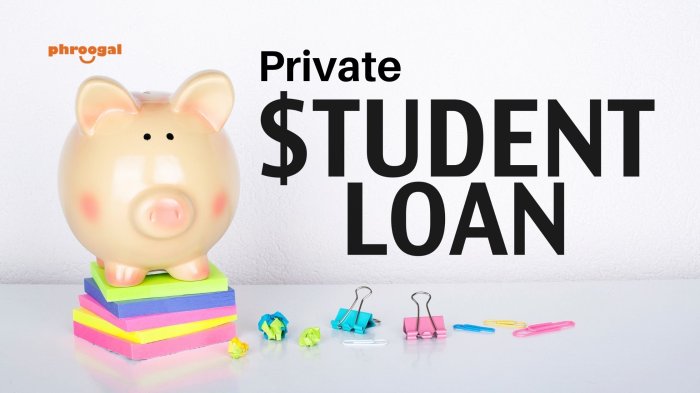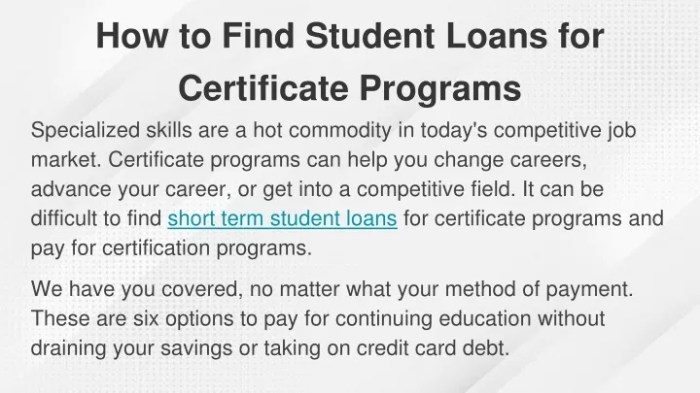
Navigating the world of student loans can feel overwhelming, but understanding the process is crucial for securing your education. This guide provides a clear and concise path to finding the right student loan, whether federal or private, to help you finance your academic pursuits. We’ll explore different loan types, eligibility criteria, application procedures, and repayment strategies, empowering you to make informed decisions about your financial future.
From comparing interest rates and repayment options to understanding the nuances of federal and private loans, this guide equips you with the knowledge to confidently manage the student loan process. We’ll also delve into strategies for minimizing debt, exploring loan forgiveness programs and resources to assist you every step of the way.
Determining Eligibility and Loan Amounts

Securing student loans involves understanding the eligibility criteria and determining the appropriate loan amount. This process requires careful consideration of several factors to ensure you borrow responsibly and avoid overwhelming debt. Navigating this process effectively can significantly impact your financial future.
Eligibility for student loans hinges on several key factors. Lenders assess your creditworthiness, income, and academic standing to determine your risk profile and loan eligibility.
Factors Influencing Student Loan Eligibility
Credit history, while not always a requirement for federal student loans, plays a crucial role in securing private loans. A strong credit score demonstrates responsible financial behavior, increasing your chances of approval and potentially securing better interest rates. Conversely, a poor credit history or lack of credit history may limit your options or result in higher interest rates. Income, particularly parental income for dependent students, is considered by both federal and private lenders to assess your ability to repay the loan. Finally, maintaining satisfactory academic standing, usually a minimum GPA, is a prerequisite for continued loan eligibility. Failure to meet the academic requirements can lead to loan cancellation or suspension.
Strategies for Maximizing Loan Amounts While Minimizing Long-Term Debt
Borrowing the maximum amount possible might seem appealing, but it’s crucial to borrow only what’s necessary for educational expenses. Careful budgeting and exploring alternative funding sources, such as scholarships and grants, are essential. Prioritizing grants and scholarships before taking out loans can significantly reduce your overall debt burden. Additionally, comparing loan options from various lenders, including federal and private institutions, is vital to securing the most favorable interest rates and repayment terms. Understanding the difference between subsidized and unsubsidized loans is also crucial, as subsidized loans don’t accrue interest while you’re in school. For example, a student who secures a $10,000 subsidized loan will only owe $10,000 upon graduation, whereas an unsubsidized loan of the same amount will accrue interest during the study period, leading to a higher total debt.
Completing the Free Application for Federal Student Aid (FAFSA)
The FAFSA is the gateway to federal student aid. Completing it accurately and efficiently is crucial to maximizing your financial aid opportunities.
- Gather Required Information: Before starting, gather necessary documents including Social Security numbers, federal tax returns, and bank statements for both you and your parents (if you are a dependent student).
- Create an FSA ID: You and your parents (if applicable) will need an FSA ID, which is a username and password used to access and sign your FAFSA.
- Complete the Application Online: Access the FAFSA website and begin the application. Answer all questions accurately and completely.
- Review and Submit: Carefully review your completed application for any errors before submitting it. Submit your application well before the deadlines set by your chosen institutions.
- Track Your Status: After submission, monitor your FAFSA status online to track the processing and ensure it’s been received by your schools.
The Application Process for Private Student Loans

Applying for private student loans differs significantly from the federal loan process. Federal loans are typically need-based and involve a simpler application through the Free Application for Federal Student Aid (FAFSA). Private loans, on the other hand, are offered by banks and other financial institutions and are based on creditworthiness. The application process is generally more complex and involves a credit check and often requires a co-signer.
Private student loan applications generally require more extensive documentation and a more rigorous review process compared to federal loans. The specific requirements vary by lender, but common elements include credit history assessment, income verification, and an evaluation of your ability to repay the loan.
Key Differences Between Federal and Private Student Loan Applications
Federal student loan applications primarily focus on determining financial need through the FAFSA. This application requires information about your income, assets, and family size. In contrast, private loan applications emphasize creditworthiness and repayment ability. Lenders assess your credit history, debt-to-income ratio, and overall financial stability. Federal loans typically offer more flexible repayment options and protections for borrowers, while private loan terms are often more stringent.
Comparison of Application Processes Across Three Private Lenders
To illustrate the variations in the application process, let’s compare three hypothetical private student loan providers: Lender A, Lender B, and Lender C. These are examples and do not represent specific institutions. Lender A might prioritize a streamlined online application with quick pre-qualification options, relying heavily on automated credit scoring. Lender B may offer a more personalized approach, involving a greater degree of manual review and potentially requiring additional documentation, such as proof of enrollment. Lender C might emphasize a hybrid model, combining online convenience with the option for phone consultations to assist applicants through the process. Each lender will have its own unique application portal and requirements.
Required Documents for Private Loan Applications
Private student loan applications typically require a comprehensive set of documents to verify your identity, income, and creditworthiness. Commonly requested documents include:
- Government-issued photo identification: Such as a driver’s license or passport.
- Social Security number: Used for credit checks and verification.
- Proof of enrollment: An acceptance letter or enrollment verification from your educational institution.
- Bank statements: To demonstrate your financial stability and account history.
- Tax returns: Used to verify income and assess your financial situation.
- Credit report: Lenders will access your credit report to evaluate your credit history and risk profile.
- Co-signer information (if required): If you lack sufficient credit history, a co-signer with good credit may be necessary. This will require their identifying information and financial documentation.
It is crucial to carefully review the specific requirements of each lender before applying to ensure you have all the necessary documents readily available. Incomplete applications can delay the approval process.
Exploring Loan Forgiveness and Repayment Assistance Programs

Navigating the complexities of student loan repayment can be daunting. Fortunately, several federal and state programs offer loan forgiveness or repayment assistance to help borrowers manage their debt. Understanding these programs and their eligibility requirements is crucial for effective debt management. This section will explore some key programs, highlighting their benefits and drawbacks.
Income-Driven Repayment (IDR) Plans
IDR plans adjust your monthly student loan payments based on your income and family size. Several IDR plans exist, including Income-Based Repayment (IBR), Pay As You Earn (PAYE), Revised Pay As You Earn (REPAYE), and Income-Contingent Repayment (ICR). Eligibility generally requires federal student loans and completing an application. The primary benefit is lower monthly payments, potentially making repayment more manageable. However, a drawback is that you may end up paying more interest over the life of the loan, and the remaining balance might be forgiven after 20 or 25 years, depending on the plan, which is considered taxable income.
Public Service Loan Forgiveness (PSLF) Program
The PSLF program forgives the remaining balance on your federal student loans after you’ve made 120 qualifying monthly payments under an IDR plan while working full-time for a qualifying government or non-profit organization. Eligibility requires federal Direct Loans and consistent employment with a qualifying employer. The significant benefit is complete loan forgiveness. A major drawback is the stringent requirements, including the need for consistent employment and adherence to specific payment plans. For example, a teacher working for a public school for 10 years and making consistent payments under an IDR plan could qualify.
Teacher Loan Forgiveness Program
This program offers forgiveness of up to $17,500 on federal student loans for teachers who have completed five years of full-time teaching in a low-income school or educational service agency. Eligibility requires teaching in a qualifying school and having federal student loans. The benefit is substantial loan forgiveness for those dedicated to teaching in underserved communities. A limitation is the specific requirements related to school type and teaching experience.
Other State and Federal Programs
Numerous other state and federal programs offer loan forgiveness or repayment assistance, often targeting specific professions or demographics. These programs may have varying eligibility requirements and benefits. For example, some states offer loan forgiveness programs for healthcare professionals who work in underserved areas. It’s crucial to research programs specific to your state and profession to determine eligibility. These programs are often subject to funding limitations and may change.
Concluding Remarks
Securing funding for your education shouldn’t be a daunting task. By carefully considering the various types of student loans, understanding the application processes, and planning for repayment, you can effectively manage your student loan debt and achieve your academic goals. Remember to utilize the resources available and seek professional advice when needed. With careful planning and informed decision-making, you can navigate the student loan landscape successfully and confidently invest in your future.
Popular Questions
What is the difference between a subsidized and unsubsidized federal loan?
Subsidized loans don’t accrue interest while you’re in school, grace periods, and during deferment. Unsubsidized loans accrue interest throughout the loan’s life.
Can I refinance my student loans?
Yes, refinancing can lower your interest rate and monthly payment, but it often involves switching from a federal to a private loan, potentially losing federal protections.
What happens if I default on my student loans?
Defaulting can lead to wage garnishment, tax refund offset, and damage to your credit score, making it difficult to obtain future loans or credit.
How long does it take to get approved for a student loan?
Processing times vary depending on the lender and the type of loan. Federal loans generally take a few weeks, while private loans can take longer.
Where can I find a list of reputable student loan lenders?
Check the websites of the National Education Association, the Consumer Financial Protection Bureau (CFPB), and your school’s financial aid office for lists and comparisons of lenders.
